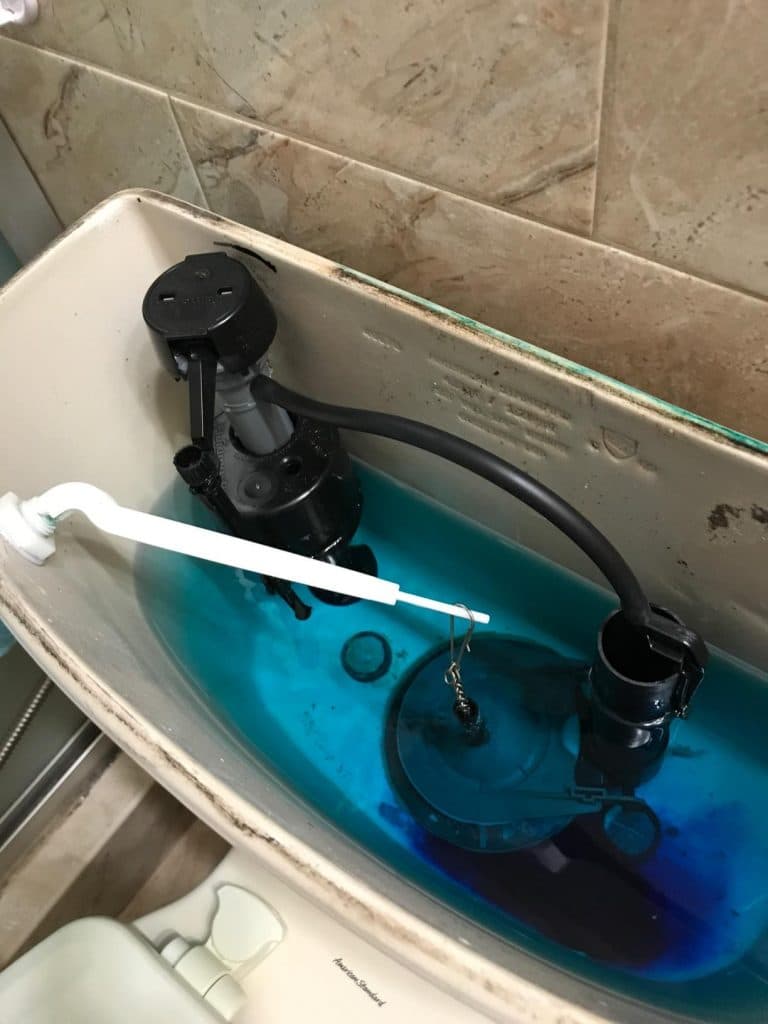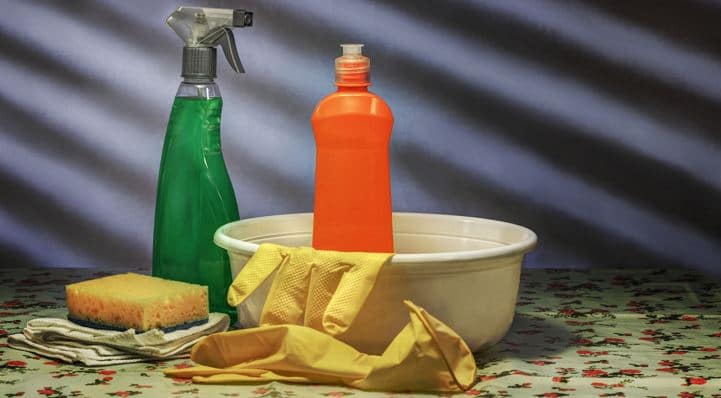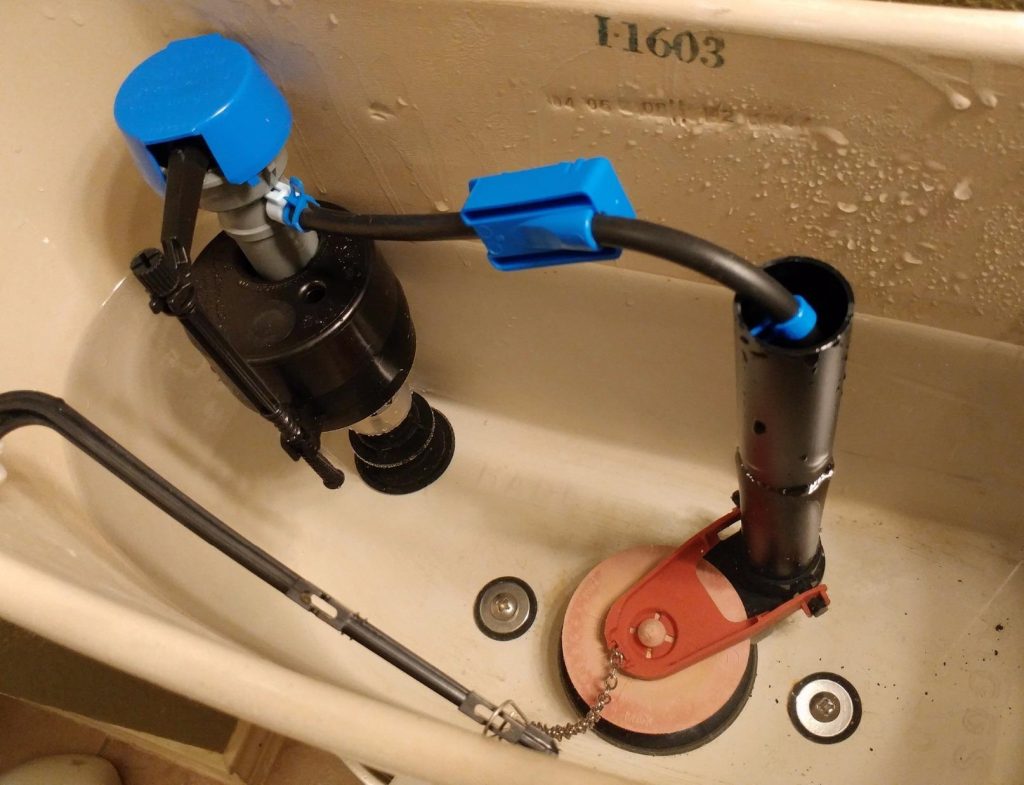How to Clean a Toilet Tank – Don’t Bleach Again
Last Updated on July 27, 2023 by toilethaven
Most people have never seen the inside of their toilet tanks. Some don’t even know how a toilet tank works. To some, it is just a water reservoir for flushing the toilet.
It doesn’t help much that the toilet tank is permanently closed. This is why most people always remember to clean the toilet bowl and not the tank.
But why would anyone want to clean a toilet tank? At least we know what happens in the bowl, but the tank! What could possibly happen inside the toilet tank that would necessitate the need to clean it?
The first time I saw the inside of my toilet tank, I didn’t believe what I saw. The base of the tank was literally black. The walls are brown. I initially wanted to replace the toilet flapper but spent the entire afternoon cleaning the toilet tank.
A toilet tank is placed on top of the toilet bowl by design rather than by accident. It makes it possible to flush the toilet with the help of the natural force of gravity. The tank is connected to the house water system by the toilet water supply line.
A toilet tank is covered with a lid at all times, and most bathrooms are cleaned daily. How, then, does the tank get dirty?
To clean a toilet tank, turn off the water supply and drain the tank. Fill the tank with vinegar to the top of the overflow tube and let it sit for 12 hours. Flush down the vinegar, spray a disinfectant inside the tank, and use a brush to scrub it. Avoid using chemicals like bleach and acids.
How Does a Toilet Tank Get Dirty?

Before water gets to your toilet tank, it has to come from somewhere. The toilet tank’s most common type of dirt is minerals from the water supply.
When water is pumped, it is difficult to see them, but when it settles in the tank, the minerals are deposited at the bottom and walls of the tank. Continuous depositing over a period of time form a layer at the bottom of the tank and also stains its walls.
Hard water stains in the toilet bowl are also a result of these minerals. The most common ones are iron, calcium, and manganese.
Water is pumped into the toilet tank at high pressure. If the pipes transporting the water are corroded, the scrapped-off corrosions will be deposited inside the tank. Over a period of time, the inside of the tank will have brownish sediments.
The toilet tank is also a natural habitat for mold and algae. As a result, the water in the tank will turn cloudy and greenish.
Why You Need to Clean a Toilet Tank
Most people don’t see the need to clean a toilet. They only clean the exterior but completely ignore the inside. But why is it so important to clean the inside of your toilet tank?
1. For a Powerful and Better Flush
Have you ever noticed that when a toilet is brand new, it flushes amazingly well, but after a few years or months (depending on where you live), it starts to flush poorly? What do you think causes this?
Dirt and mineral deposits are embedded in your toilet tank’s waterways, inhibiting the natural water flow. Water from the tank enters the bowl via the rim holes and a siphon jet at the bottom of the bowl.
The water pressure is greatly reduced when the dirt clogs the siphon jet and rim holes from the tank. You would then need to flush the toilet twice or thrice, which is irritating.
Regularly cleaning your toilet tank ensures that you always have a powerful flushing toilet since the rim holes and siphon jets are always clear.
Read more about cleaning a toilet siphon jet and rim holes here.
2. Prevent a Running Toilet
A running toilet is not only irritating but expensive. With every passing minute, water will be dripping into your toilet bowl from the tank. Although a running toilet is not always caused a dirty toilet tank, most of the time, cleaning the tank is enough to fix it.
When you have lots of debris and mineral deposits inside your toilet tank, some will be embedded below the toilet flapper. The toilet flapper is the rubber seal on top of the flush valve to prevent water from flowing down to the bowl. It is connected to the flush handle via a lift chain and should only lift off during flushing.
When the debris is trapped between the flapper and the flush valve opening, water will continuously run from the tank to the bowl. Cleaning the toilet tank will fix this problem.
Debris and minerals can also be deposited inside the toilet fill valve. When this happens, the fill valve will not be able to shut even when the tank is full, causing a running toilet.
To learn more on how to fix a running toilet, check out this post.
3. Prevent Awful Odors
The inside of a toilet tank is a good haven for mold, mildew, and odor-causing bacteria. If you want your bathroom to constantly smell fresh, then you need to start cleaning your toilet tank frequently.
Some people use artificial fragrances to cover the awful smell, but you don’t need to do that. Apart from eliminating the bad odors, cleaning your toilet tank will also ensure that you and your family are some from diseases.
4. Prolong Your Toilet Tank Parts
If you don’t want to keep replacing your toilet tank parts, then I suggest that you get in the habit of cleaning your toilet tank regularly. Mineral deposits will cause your toilet flapper to warp and tank bolt washers to weaken hence leaking and many other problems.
Toilet tank parts may not be very expensive, but plumbers are. It is also inconvenient when you have a constantly running/leaking toilet.
How to Clean a Toilet Tank Naturally.
There are several ways to clean a toilet tank, some of which are great and some of which I would not recommend. Cleaning a toilet tank is different from cleaning the bowl.
To start with, the bowl is all porcelain and is relatively easy to clean. The inside of the toilet tank, on the other hand, has many parts, some of which are made of rubber.
While cleaning a toilet tank, you need to make sure that you choose a cleaner that will do the actual job and also not destroy these parts.
You do not want to use a cleaner that will eat away all the rubber seals and parts. This is how you will end up with a running toilet.
It is also good to pick a toilet cleaner that is eco-friendly and, most importantly, sept-safe if you are on a septic system. Check out the best septic-safe toilet cleaners here.
Materials and Items Needed
- White vinegar
- Baking soda
- Rubber gloves
- Disinfectant
- Long brush
- Toothbrush
- Sponge
Depending on the tank’s condition, you might decide to clean it with a basic disinfectant or white vinegar if it is in dire condition.
How to Clean a Toilet Using a Disinfectant

If your water tank is in relatively good condition with little dirt, you should use your normal disinfectant to clean it. These are the steps to follow:
- Turn off the water shut-off valve. You will find this valve on the back side of the toilet.
- Flush your toilet and hold the flushing lever down until the tank is empty
- Wear your gloves.
- Use your sponge to mop out the little water at the bottom of the tank. Use this chance to remove some dirt/debris before using the disinfectant.
- Spray your disinfectant all around the toilet tank, focusing more on the walls and the bottom.
- Remove your gloves and wash your hands with soap
- Take a 10 to 15-minute coffee break.
- Come back to work and wear your gloves.
- Use your long brush to scrub every area of the toilet tank.
- Use a toothbrush to clean in between areas. You cannot use the big brush.
- Open the water inlet valve and let the water fill in the tank.
- Flush a few times to rinse the tank completely.
- Clean the lid in the sink and cover the tank.
- Repeat twice a year.
How to Clean a Toilet Tank using Vinegar and Baking Soda
If your toilet tank is stained and discolored after many years of mineral deposits, you need something more aggressive than a disinfectant. White vinegar and baking soda will do the job for you.
Vinegar’s acidity will eat into these stains and scales, making it a perfect choice—baking soda, which is a natural cleaner, is alkaline and will hence combine perfectly with the vinegar.
You can also use borax, a stronger cleaning agent than baking soda. Borax is, however, banned in Europe but legal in the United States.
This is how to clean a toilet using vinegar and baking soda:
- Turn off the water shut-off valve.
- Flush the toilet and mop out all the remaining water in the tank with a sponge.
- Pour one cup of baking soda into the toilet tank.
- Add white vinegar inside the toilet tank up to just below the overflow tube. The overflow tube is the large tube inside the tank that prevents the toilet from overflowing.
- You should add the vinegar slowly as it reacts quickly with baking soda and might spill over.
- Leave the solution for up to 12 hours or preferably overnight.
- Flush down all the vinegar.
- Put on your gloves.
- Nicely spray your disinfectant all around the inside of the tank (optional).
- Leave it for 10-15 minutes to work.
- Take your long brush and get to work. Use a toothbrush to thoroughly clean between small spaces your big brush cannot reach.
- Clean away all the stains until you are satisfied with the results.
- Turn on the water shut-off valve.
- Let the water fill the tank. Flush the toilet several times to rinse the tank and all the tank parts.
- You can take this chance to do all the toilet tank repairs you deem necessary.
- Check the flapper’s condition and ensure no debris is embedded underneath and on top of the flush valve opening.
- Also, ensure the fill valve works flawlessly and that the water level in the tank is as it should be.
- Clean the lid in a nearby sink and cover the tank.

You might also be interested in the following:
- How to get rid of a toilet ring – This is the ring that forms inside the toilet bowl around the waterline as a result of hard water stains.
- How to clean toilet rust stains – These are brown stains found inside the toilet tank and the bowl.
- How to make a toilet flush better – if your toilet’s flushing power has greatly decreased, you must read this.
- Best toilet tank repairs kits – If you want to replace one of your toilet tank parts or completely rebuild it.
Keeping the Toilet Tank Clean
Learning how to clean a toilet tank is one thing. Knowing how to keep it clean at all times is another thing altogether. It is exceedingly important that you take good care of your toilet tank. It will, in return, save you a lot of headaches and plumbing costs. There are 2 main ways to keep your toilet tank in good condition:
1. Clean the toilet tank at least twice a year
Unlike a toilet bowl which needs frequent cleaning, two times a year will be sufficient for a toilet tank. It is therefore important for you to schedule the 2 dates which you will dedicate to this task
2. Pour vinegar regularly
Check the condition of your toilet tank from time to time. When minerals and stains build up, fill the tank with vinegar. Flush it down after 12 hours.
Do not also forget to pour vinegar inside the overflow tube. This will be the one to make sure that your rim holes and siphon jets are always open.
Toilet Tank Tablets – Are They Safe
Toilet tank tablets are placed in the tanks to give them a fresh smell. They also help to dissolve the minerals and other contaminants in the tank. In simple language, toilet tank tablets clean the toilet for you, so you don’t need to.
They are advertised as the best way to clean a toilet tank without scrubbing. They also make it possible to clean a toilet tank without draining it.
Should, however, use toilet tank tablets? Are toilet tank tablets safe for use? These are some of the questions I often hear people ask.
Toilet tank tablets may seem like a great choice for cleaning toilet tanks, but they are not. These are the reasons/;
- Most toilet tank tablets are made of chlorine which dissolves in the water and starts attacking all the rubber parts of the toilet tank, like the flapper and fill valve. After some time, the toilet will start running/leaking.
- While you can scrub away the stains using vinegar, baking soda, and a brush, toilet tank tablets will not. They are, therefore, not a good replacement for the real thing.
- Toilet tank tablets will not remove debris from a toilet tank. If you have an obstructed flapper, no amount of tank tablets will clean it, and you will constantly have a running toilet.
- Tank tablets are bad for the environment, especially when on a septic system.
FAQs
- How do I clean toilet tank rust?
This is how to clean a toilet tank rust:
- Turn off the water inlet valve
- Flush the toilet
- Fill the tank with vinegar up to just below the overflow tube
- Wait for 12 hours
- Spray a disinfectant
- Wait for 15 minutes
- Scrub thoroughly
- Open the water valve
- Flush and rinse the tank
2. Can I put bleach in the toilet tank?
Bleach is not recommended inside the toilet tank. The bleach would destroy the rubber and plastic components over time, leading to expensive repairs/replacements.
3. How should I clean the wall behind the toilet tank?
Remove the toilet tank lid and use a yardstick with a wet towel on its end. This may, however, not work for all toilets.